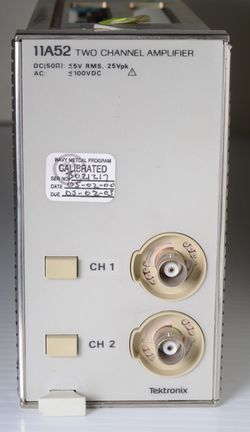11A52: Difference between revisions
No edit summary |
No edit summary |
||
| Line 1: | Line 1: | ||
{{Plugin Sidebar | {{Plugin Sidebar | ||
|manufacturer=Tektronix | |||
summary=Dual channel 600 MHz amplifier | | |series=11000-series scopes | ||
image=Tek 11a52 front.jpg | | |type=11A52 | ||
caption=Tek 11A52 | |summary=Dual channel 600 MHz amplifier | ||
|image=Tek 11a52 front.jpg | |||
introduced=1987 | | |caption=Tek 11A52 | ||
discontinued=(?) | | |introduced=1987 | ||
manuals= | |discontinued=(?) | ||
|designers= | |||
|manuals= | |||
* [http://w140.com/tek_11a52_user.pdf Tektronix 11A52 User Manual (PDF)] | * [http://w140.com/tek_11a52_user.pdf Tektronix 11A52 User Manual (PDF)] | ||
* [[Media:070-7391-99.pdf|Tektronix 11A52 Extended Service Manual (PDF)]] | * [[Media:070-7391-99.pdf|Tektronix 11A52 Extended Service Manual (PDF)]] | ||
| Line 33: | Line 35: | ||
It uses custom Tek chips including the [[155-0076-00]] (M94 overload detector) and [[M377]] amplifier chip. | It uses custom Tek chips including the [[155-0076-00]] (M94 overload detector) and [[M377]] amplifier chip. | ||
In the 11A52, the digital output of the M94 overload detectors (one per channel) | In the 11A52, the digital output of the M94 overload detectors (one per channel) are received by the microprocessor. | ||
are received by the microprocessor. | If overload is detected, software running in the microprocessor switches the input relay to remove the signal from the 50 Ω attenuator. | ||
If overload is detected, software running in the microprocessor switches the input relay | |||
to remove the signal from the 50 Ω attenuator. | |||
This is in contrast to the [[485]], where the M94 directly controls the input relay. | This is in contrast to the [[485]], where the M94 directly controls the input relay. | ||
During the 11A52's self-check, the M94 IC for each channel is tested. | During the 11A52's self-check, the M94 IC for each channel is tested. | ||
An analog switch injects test currents, positive and negative, | An analog switch injects test currents, positive and negative, into the summing junction at the input of each M94. | ||
into the summing junction at the input of each M94. | |||
The outputs are checked by the self-check software routine. | The outputs are checked by the self-check software routine. | ||
Revision as of 12:55, 13 August 2021
The Tektronix 11A52 is a 600 MHz dual-channel plug-in for 11000-series and DSA600-series scopes. It has Tekprobe BNC connector inputs.
Key Specifications
| Bandwidth | DC to 600 MHz plus 100 MHz and 20 MHz BWL filters |
|---|---|
| Number of Inputs | 2 |
| Rise time | 580 ps in 1 GHz mainframe such as the 11402, 11402A. 11403, 11403A, DSA601A, or DSA602A |
| Deflection | 1 mV to 10V per division in 1% calibrated steps |
| Input impedance | 50 Ω |
| Features |
|
Internals
It uses custom Tek chips including the 155-0076-00 (M94 overload detector) and M377 amplifier chip.
In the 11A52, the digital output of the M94 overload detectors (one per channel) are received by the microprocessor. If overload is detected, software running in the microprocessor switches the input relay to remove the signal from the 50 Ω attenuator. This is in contrast to the 485, where the M94 directly controls the input relay.
During the 11A52's self-check, the M94 IC for each channel is tested. An analog switch injects test currents, positive and negative, into the summing junction at the input of each M94. The outputs are checked by the self-check software routine.
Links
Pictures
-
11A52 front
-
-
-
front panel connections
-
-
signal relays, top
-
signal relays, bottom
-
-
-
-
-
-
sample/hold modules
-
-
Input Attenuators Schematic
-
Kernel Schematic
-
Analog Control and Signal Amps

















